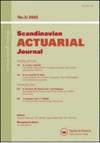相关性对(范围)风险价值的影响
IF 1.4
3区 经济学
Q3 MATHEMATICS, INTERDISCIPLINARY APPLICATIONS
引用次数: 0
摘要
投资组合风险的评估通常是明确的(如巴塞尔协议III的平方根公式)或隐含的(如信用风险模型),由风险成分的边际分布及其相关性驱动。我们评估这种做法容易产生模型错误的程度。在n = 2风险的情况下,我们研究了在哪些条件下,无约束的风险价值(VaR)界限(当只有边际分布已知时的最大和最小VaR)与(约束的)VaR界限重合,当另外一个有一些依赖度量(例如Pearson相关或Spearman's rho)的信息时。我们发现,如果相关测度在明确确定的区间内取值,则两个界重合。对于风险管理实践中使用的概率水平,我们表明,使用相关信息通常对最高可能的VaR没有影响,而可以影响最低可能的VaR。在一般风险总和的情况下,我们在平均相关性约束下推导出风险范围值(RVaR)界限,并表明它们在标准均匀分布风险总和的情况下是最佳可能的。本文章由计算机程序翻译,如有差异,请以英文原文为准。
The impact of correlation on (Range) Value-at-Risk
The assessment of portfolio risk is often explicitly (e.g. the Basel III square root formula) or implicitly (e.g. credit risk models) driven by the marginal distributions of the risky components and their correlations. We assess the extent by which such practice is prone to model error. In the case of n = 2 risks, we investigate under which conditions the unconstrained Value-at-Risk (VaR) bounds (which are the maximum and minimum VaR for when only the marginal distributions of the are known) coincide with the (constrained) VaR bounds when in addition one has information on some measure of dependence (e.g. Pearson correlation or Spearman's rho). We find that both bounds coincide if the measure of dependence takes value in an interval that we explicitly determine. For probability levels used in risk management practice, we show that using correlation information has typically no effect on the highest possible VaR whereas it can affect the lowest possible VaR. In the case of a general sum of risks, we derive Range Value-at-Risk (RVaR) bounds under an average correlation constraint and we show they are best-possible in the case of a sum of standard uniformly distributed risks.
求助全文
通过发布文献求助,成功后即可免费获取论文全文。
去求助
来源期刊

Scandinavian Actuarial Journal
MATHEMATICS, INTERDISCIPLINARY APPLICATIONS-STATISTICS & PROBABILITY
CiteScore
3.30
自引率
11.10%
发文量
38
审稿时长
>12 weeks
期刊介绍:
Scandinavian Actuarial Journal is a journal for actuarial sciences that deals, in theory and application, with mathematical methods for insurance and related matters.
The bounds of actuarial mathematics are determined by the area of application rather than by uniformity of methods and techniques. Therefore, a paper of interest to Scandinavian Actuarial Journal may have its theoretical basis in probability theory, statistics, operations research, numerical analysis, computer science, demography, mathematical economics, or any other area of applied mathematics; the main criterion is that the paper should be of specific relevance to actuarial applications.
 求助内容:
求助内容: 应助结果提醒方式:
应助结果提醒方式:


